God of War: Ragnarök review - glorious excess makes a triumphant return
Bigger and Baldur.
Despite the ostensibly modern tone, God of War's Norse revival has always seemed retro by nature. That 2018 mega-hit, and indeed God of War: Ragnarök, its hugely anticipated follow-up, are Metroidvanias at heart, games that have you explore a world of mazing, criss-crossing tunnels and interlocking paths, that tease you past closed doors waiting to be opened on some later, more empowered return, or through secret ones you never knew existed.
These worlds live in service to two of video games' most distinctly video-gamey moments: the "Aha! At last," of finally smashing that purple obstacle with your new purple spell, and the "Huh! Didn't expect to wind up here" of emerging into sunlight through the exit of some dark, hidden passageway, pockets clinking with the sound of plundered gold. The result is a curious tension. Of all the recent blockbusters awarded the dubious title of "cinematic experience," God of War was the one that still carried the untamed heart of a video game.
It might seem a tiny bit facile, but that tension really was the crux of 2018's game: just as Kratos attempted to move on from a past he looked upon with shame, the series attempted to leave its excessive, often puerile tendencies behind, replacing quick-time-event sex scenes and cartoonish style with a solemn, intimate father-son tale. There's an argument, however, that God of War maybe over-compensated just a tad, its self-seriousness occasionally turning to a naval-gazing self-regard. But still it couldn't help itself: Godly skulls were pummelled, wolfman jaws were ripped off, somewhere in there, buried and denied, the old Kratos never really went away.
 Bloated But Beautiful: SPOILER-FREE GOD OF WAR RAGNAROK REVIEW! GOD OF WAR RAGNAROK NEW PS5 GAMEPLAY
Bloated But Beautiful: SPOILER-FREE GOD OF WAR RAGNAROK REVIEW! GOD OF WAR RAGNAROK NEW PS5 GAMEPLAY
In Ragnarök that tension continues. If anything its dialled up, in the way that many sequels often are, each of the disparate parts - the size of the world, the length of the story, the number of characters and skill trees, crafting screens, and pixels on the TV - growing exponentially, the emphasis on providing more of what people loved, rather than the balance of how it all knits together. But, crucially, this is a tension Ragnarök aims to resolve. And it does. After taking an awful lot of time to think about it, this game, like its protagonists, realises what it truly is, and finally learns to love itself for it. The result is big and silly - and deliriously satisfying.
God of War: Ragnarök picks up three years after the events of God of War, with Kratos and his son Atreus - never "Boy" in Ragnarök - hiding out in their humble cabin. Atreus is "coming into some powers," as teenage gods do, and coming into a bit of an attitude problem as well, not helped by the obscured prophecy found at the end of God of War. The events of the previous game have had consequences, too: Freya, Queen of the imposing Valkyries and mother to the slain villain-god Baldur, has turned from ally to nemesis, desperate for revenge.


Parental wrath is, unsurprisingly, a running theme here. Magni and Modi, two more insufferable Norse gods, or Aesir, were also killed by us in the first game and have a rueful father in Thor, wonderfully imagined as a towering, belligerent strongman - eventually he proves a mirror for Kratos, a what-if outcome, were he to let his self-loathing run free. Most important of all is Baldur's father and 'All Father' of the nine realms, Odin, a master of knowledge and spies rendered here as a kind of magnanimous mob boss, cloak draped over his shoulders like both the closed wings of his ravens and the overcoat of Don Fanucci.
The Aesir take more prominence in God of War: Ragnarök than you might initially expect, and they're an odd bunch, as the characters of Norse mythology are in general. Their inter-family feuds play out with mixed success - Freya takes surprising, but well-earned prominence in a few ways, and her quest for retribution feels powerful. Others feel like crossovers from the Twilight Saga, all pallid and pompous and unnervingly West Coast. Ragnarök, as a concluding entry to this only two game long saga, clearly feels a pressure to include as much of the canon as possible, a completionist streak that can leave it feeling both bloated and crowded as a result. It can't help but keep throwing more characters at you, more references to backstory lore or minor incidents from the previous game, to the extent that I half expected the log you carry during the first tutorial to turn up and deliver a soliloquy.
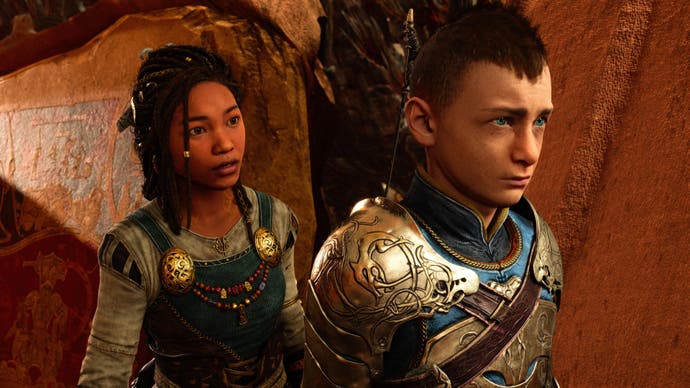
This bloat is without doubt the biggest problem for Ragnarök. With more efficiency its story could be told in half the time, with half the characters, and in its tropey, misunderstanding-fuelled middle hours it sags under the weight of it all, falling into the mopier tendencies of the previous game but without the tight, double-act focus that kept it moving. There are a huge amount of cutscenes, which flow beautifully in and out of the player-controlled action with more sophistication than ever - God of War isn't the only game to use a one-shot take for its camerawork, but I still marvel at it, the amount of cross-team coordination that must take.
But there are still too many of them, forgotten lovers and brothers and probably someone's cousin's pet dog getting lengthy screen time each - likely, I suspect, because of an urge to "do justice" to each minor character's arc, to prevent them from feeling used by the story. If that's the reason, it's slightly misguided thinking - there are more tools in the best writers' arsenals than lengthy conversation for making characters feel alive. A single, well-formed expression can deliver as much depth and nuance as half an hour with some of Ragnarök's chats.
In these moments the story's problems seep into its gameplay, each puzzle feeling more and more like it exists purely to stall for time so yet more quippy Marvel banter can be used to retreat the same exhausted, overstretched themes once more - trust! Self-doubt! Fate and prophecy! This is part of the natural tension with games like God of War: Ragnarök. For a game designed around play sessions that last for one self-contained hour, it makes complete sense to rehash conversations in order to embed you back into a story you might've spent a week away from. In longer chunks though, it struggles - a victim of the intense way these games are reviewed, sure but plenty will blast through sections over a weekend, by the end of which you might marvel at the amount of words shared without an inkling of progress.


Chatter is also a key problem for that puzzling, too, which makes up at least a solid half of what you'll be doing in God of War: Ragnarök. I love God of War's puzzles. They're simple and mechanistic but tuned in such a way as to just tickle the exact right part of your brain, the lizardy bit that likes tightening screws on wobbly chairs and lining notebooks up with the edge of your desk. This goes here, put that on that, turn this and, tada! Open sesame. I never tire of it, and there are more than ever in Ragnarök.
But Ragnarök does try its best to undermine my enjoyment at times, thanks to a truly overbearing urge to offer you hints. You will not look at a puzzle for more than a few seconds before one companion or another (there are many, all as overeager as the next) tells you the solution. "Maybe that lever could help, brother!" Yeah? The lever I'm pulling right now? You don't say, Mimir! The joy of these puzzles is that they are actually incredibly simple but they make you feel like they're complicated because of the visuals, the sense of whirring mechanism, all the satisfaction coming from how you feel smart for solving them, watching the micro-chain of cause and effect start to flow like you're the master of your little universe. Patronising you with a solution before you can even nock the required magic arrow - and a dog-training "Well done!" after the fact, for good measure - often spoils the fun.
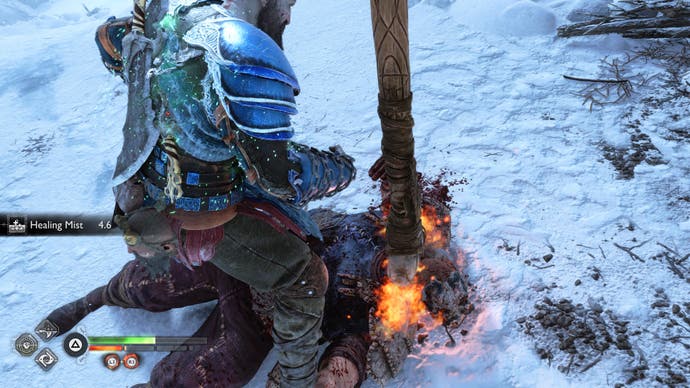
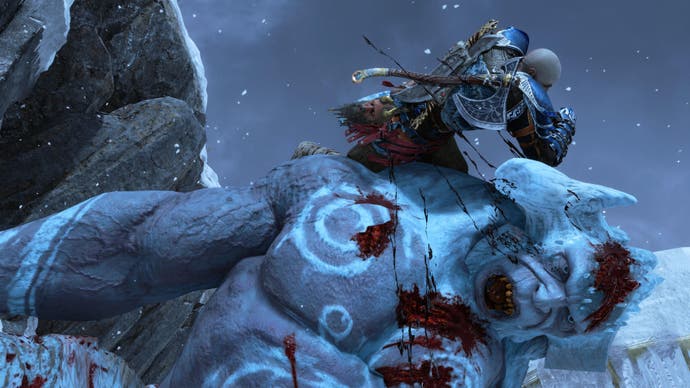
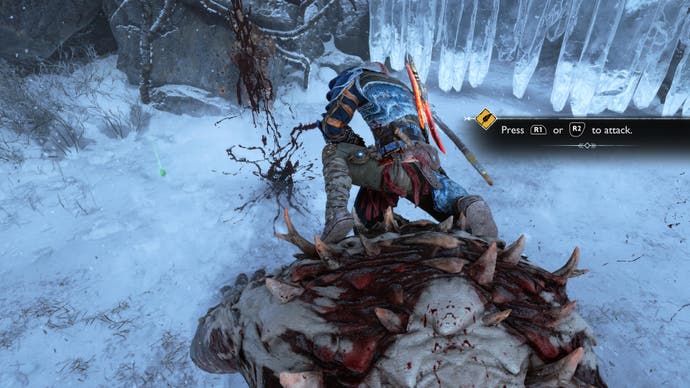
Crucially, though, there is an awful lot of fun. The flipside to having an overlong story is that it means there is simply more of this game, something the majority will want - as I did, to my surprise, even after finally reaching its end - and will gladly pay the price of a few more skippable cutscenes to enjoy. The world of God of War: Ragnarök is vast and really quite strange - I spent a large part of my time with it reaching for the right analogy to describe it, but really, Ragnarök is a theme park.
In fact, it's a lot like a theme park - the more you sit with that thought the more it all lines up. Along your journey you will ride rollercoasters through mountains, log flumes through mines, take oh-so-many guided boat tours through new regions - Elf land! Dwarf land! The one where you'll get to pet wild animals! You'll meet your favourite heroes. You'll wonder how Brok and Sindri, the walking mascots of this universe, will manage to appear simultaneously in one realm and some other, but never two at once. Do they have some secret network of mascot tunnels? Multiple actors in the same costumes? Each side mission functions as an attraction, often a literal island with a tightly contained ten minutes of fun. The closer you look the more irrefutable it becomes, from the way the game's extras move like animatronic puppets behind picket fences and tavern bars, right down to the invisible walls along its many linear paths, that all seem to guide you, through the mystic art of psychological engineering - the spacing of paving slabs, the use of light - from one attraction to the next. By the end it's clear: this is a complete Disney World of Adventure through the nine Norse realms.

I mean this as a compliment. One of Ragnarök's real achievements is in how it has progressed beyond a reliance on mere visual fidelity to provide its spectacle. It's mined Norse myths for their weirdness, their idiosyncrasies that set them apart and give this modern series its oddly gaudy, outsized charm. It has fun with size, in fact, having you duck beneath dwarven rafters one moment and scarper about amongst giant bric-a-brac the next. Its realms are more varied, less oppressive and so more inviting for your eventual return, and gloriously colourful but importantly, playful with that colour. Big, platform tentpole blockbusters, much like the recent output from Marvel, their cousins in entertainment, often equate vivid colour (usually purple) with cohesive visual creativity, but Ragnarök makes some effort in places to play with texture and tone, if still not really going for it with form.
Ragnarök's dramatic might comes from its unique access to a sense of scale, a sense that was so sorely missed in the previous game and remedied with conviction here at last.
Combat, similarly, retains much of its structural rigidness, which in this case is a slight shame. I would've loved a more systemic approach to its elements, of which there are a few now - I can imagine a world where this game lets you manipulate enemies in more interesting ways, throwing them into one another after a grab with the Blades of Chaos for instance, rather than the usual pull-you-to-me, or me-to-you whiplash. There is a bit of synergy across skills that do more damage when using your frosty Leviathan axe on an enemy you've set ablaze, for instance, but there's very little room for expression.
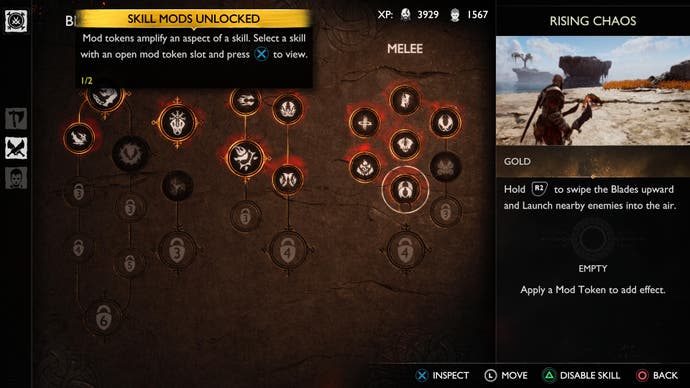
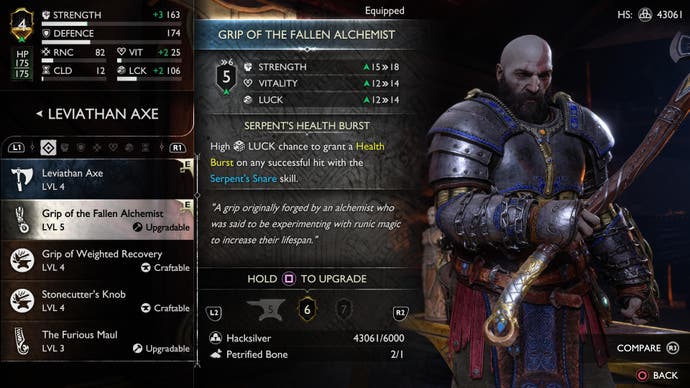
Fights in this game are designed to be structured cinema, where you can chain a few high-cooldown abilities with sumptuous, choreographed fluidity (a quick word on how animations can cancel from an attack into an execution, for instance, without you breaking flow for even a moment: stunning work). This style will make for some marvellous GIFs and glittering social media compilations, and the sense of impact - the attention to each flick of the wrist, click of the fingers, glint of metal, clang of armour, scream of rage, even the timing of combat frames and the basics of keeping battlefields plain so the combat itself and burst with visual noise - is just unparalleled. But the satisfaction that this is all for is immediate, which is the best and worst part of it all: at any moment you can hold L1 and press R2 to feel like a god, but the deeper sense of achievement in games will always come from overcoming the odds in the face of your mortality.
Much of the last God of War's shortcomings - and there were a few - have been thoroughly mended here, though. Enemy variety was a justified complaint, and clearly heard loud and clear at Santa Monica Studio (one previously ever-present enemy type is even acknowledged with some nicely self-deprecating humour). There's no risk of repetition in Ragnarök. There are far more designs, but variety comes with more depth than that too. You'll need to use a far wider range of abilities to get by - shield bashes, companion abilities, weapons - and adapt to attacks of different speed, height, and direction. Occasionally the over-the-shoulder camera is a little tight, and despite a button for quickly switching to behind you this can still be a bit of a hindrance.
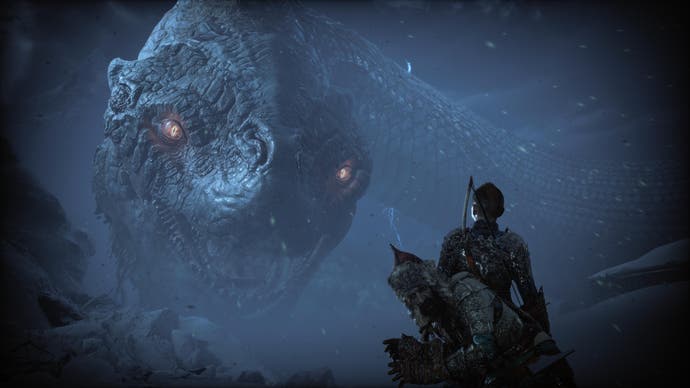
But still, the variety of it all - bosses in particular, is a real boon, a vast improvement from 2018. Within minutes you'll have fought what feels like more sub-bosses than the entirety of the previous game could offer. Many of these are quite typical - prepare to aim for glowing weak spots and turn attacks against their owners - but there are so many different ones it never feels rote.
They also improve dramatically as time goes by. God of War has a fight on its hands with boss encounters, thanks to a couple of superlative battles in fellow first-party exclusive Returnal. Next to the bullet hell, score attack retro vibes that game could call upon to summon flowstate zen through pounding techno and screen-filling particles it would always be a struggle, especially as there, tension came from circumstance - the sheer desperation to avoid yet another lengthy run to the boss. Here, tension is conjured through force of will, a typically desperate, occasionally overblown but never less than epic score from Bear McCreary, the pounding battle drum of Ragnarök's dialogue, those repetitive lines chanted like a prayer before war.
Above all, though, Ragnarök's dramatic might comes from its unique access to a sense of scale, a sense that was so sorely missed in the previous game and remedied with conviction here at last. You will fight some big, ugly monsters in God of War: Ragnarök, you will climb on their backs, lash at them with your blades, bellow defiance up to them from below. You'll stand silhouetted, jagged, cartoonishly angular in front of them. Finally, deep into this game, you will get a bit of the old Kratos back, a bit of PS2 excess will break free of its self-conscious cage. It takes a long time to get there, but this is a series that's needed to do a little soul-searching, to work through its own awkward teenage phase and wince at its old regrets. Its own heroes prove to be just the tonic.








